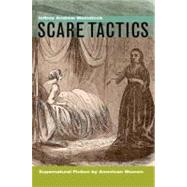Scare Tactics Supernatural Fiction by American Women
, by Weinstock, Jeffrey Andrew- ISBN: 9780823229857 | 0823229858
- Cover: Hardcover
- Copyright: 9/15/2008
Scare Tactics: Supernatural Fiction by American Women as a Form of Social Protest, 1849-1931 accomplishes three primary objectives: It establishes the existence of an important, but overlooked, tradition of supernatural writing by American women; it analyzes this tradition as an essentially feminist enterprise that imagines alternatives to a world of limited possibilities; and it engages in the work of recovery of authors important during their lifetimes and to the development of the American literary tradition, but not recognized today for their contributions. Scare Tactics is groundbreaking in establishing the existence of an important, but overlooked, tradition of female authorship in the United States. Between the end of the Civil War and roughly 1930, hundreds of uncanny tales were published by women in the periodical press and in books. These include stories by familiar figures such as Edith Wharton, Harriet Beecher Stowe, and Charlotte Perkins Gilman, as well as by authors popular during their lifetimes but almost wholly unknown to twenty-first century readers such as Josephine Dodge Bacon, Alice Brown, Emma Frances Dawson, and Harriet Prescott Spofford. Focusing on this tradition of female writing offers a corrective to the prevailing belief within American literary scholarship that the uncanny tale, exemplified by the literary productions of Irving, Poe, and Hawthorne, was displaced following the Civil War by the emerging dominant mode of literary realism. However, beyond the simple existence of an "unacknowledged tradition" of uncanny literature by women, Scare Tactics asserts that this body of literature needs to be read together as a specifically feminist literary tradition. What makes this tradition of female supernatural writing from the nineteenth and early twentieth century especially intriguing is that, again and again, women authors made use of Gothic conventions as a strategy to express discontent with the circumscribed roles for women during the period. The "ghost in the parlor" in these works repeatedly functions as a metaphor for the disenfranchised status of women who perceived themselves in various ways to be trapped or not fully present. Therefore, this body of literature must be viewed as a type of political intervention connected to the broader sphere of women's rights activism in the period between the Civil War and the 1930s. Scare Tactics finally is also notable for putting the work of established authors into dialogue with lesser known authors. The volume thus engages in the work of recovery of authors who were popular during their lifetimes, who participated in the development of the American literary tradition, and who were perceptive commentators on American culture, but who have failed to be incorporated into the canon of American literature. Paying attention to these overlooked authors helps develop a broader understanding of both the literary marketplace and the general culture of nineteenth- and early twentieth-century America and allows for rereading and expanded analysis of more familiar American Gothicists from Edgar Allan Poe to Shirley Jackson to Stephen King.







